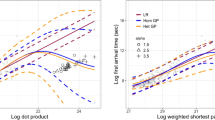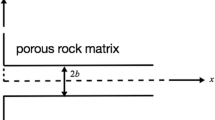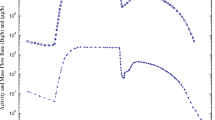Abstract
In fractured-rock aquifers, the geometric and hydraulic properties of the fractures commonly have a dominant influence on transport. Tracer tests are often used to estimate directly the gross transport properties of a fractured rock mass. The prospects for understanding characteristics of the heterogeneities in a fractured porous medium were explored from evidence provided by tracer experiments. The approach was to simulate flow and transport on a large set of prescribed fracture networks in a two-dimensional homogeneous permeable medium, thus generating synthetic tracer test data. The fracture orientation, aperture, spacing and network geometry were systematically altered from one case to the next. A classification scheme was devised for the tracer breakthrough curves using principal component analysis and this classification was linked to the fracture pattern properties. Even under highly simplified and controlled conditions, quite different fracture patterns can produce very similar breakthrough curves. The classification scheme thus demonstrates that a single breakthrough curve cannot reveal the fracture geometry with any precision. However, the scheme provided a methodology for rejecting geometric properties that do not belong to the fracture pattern under investigation, thus reducing the uncertainty in fracture geometry.
Résumé
Pour les aquifères de type fracturés, la géométrie et les propriétés hydrauliques des fractures sont en général des paramètres influençant fortement le transport. Des essais de traçage permettent souvent l’estimation directe simplifiée des propriétés de transport dans les roches fracturées. La possibilité de comprendre les caractéristiques des hétérogénéités dans un milieu fracture poreux a été explorée à partir des résultats de divers expériences de traçage. La méthode consistait à simuler les flux et le transport pour une large gamme de réseaux de fractures dans un milieu 2D perméable homogène, générant ainsi des données expérimentales de tests de traçage. L’orientation de la fracturation, l’ouverture, l’espacement et la géométrie du réseau ont été systématiquement modifiés d’un test à l’autre. Un programme de classification a été conçu pour traiter les courbes de restitution des traceurs obtenues en utilisant une analyse en composantes principales et cette classification a été reliée aux propriétés de la configuration des fractures. Même sous des conditions très simplifiées et contrôlées, des configurations de fractures très différentes peuvent générées des courbes de restitution très similaires. Le programme de classification montre ainsi qu’une simple courbe de restitution ne peut pas représenter précisément une géométrie de fracture. Toutefois, le schéma a permis une méthode pour rejeter les propriétés géométriques qui n’appartiennent pas à un modèle de fracturation étudié. Réduisant ainsi l’incertitude sur la géométrie des fractures.
Resumen
La geometría y propiedades hidráulicas de las fracturas en los acuíferos de rocas fracturadas, comúnmente tienen una influencia dominante en el transporte. Las pruebas de trazadores son utilizadas a menudo para estimar directamente las propiedades fundamentales del transporte en una masa de roca fracturada. Las perspectivas para entender las características de las heterogeneidades en un medio poroso fracturado fueron exploradas a partir de evidencias provistas por los experimentos con los trazadores. El enfoque fue simular el flujo y el transporte en un gran conjunto de redes prescriptas de fracturas en un medio permeable homogéneo bidimensional, generándose así datos sintéticos de las pruebas de trazadores. La orientación, apertura, espaciamiento y geometría de la red de las fracturas fueron sistemáticamente alteradas de un caso a otro. Un esquema de clasificación fue desarrollado para las curvas de avance (irrupción) de los trazadores utilizando el análisis de las componentes principales y esta clasificación fue vinculada con las propiedades del diseño de las fracturas. Aún bajo condiciones altamente simplificadas y controladas de muy diferentes diseños de fractura se producen curvas de avance (irrupción) muy similares. El sistema de clasificación demuestra así, que una sola curva de avance (irrupción) no tiene precisión alguna para revelar la geometría de la fractura. Sin embargo, el esquema brinda una metodología para rechazar propiedades geométricas que no pertenecen al diseño de las fracturas objeto de la investigación, reduciendo así la incerteza en la geometría de la fractura.
摘要
在裂隙含水层中, 裂隙的几何形态和水力特征通常对输运起主要影响。常用示踪试验直接评估裂隙岩体的整体输运特征。依据示踪试验结果, 探讨了认识裂隙多孔介质非均质性的前景。其方法是对事先定义好的2维均质渗透介质中的一大组裂隙网络进行流动与输运模拟, 从而生成模拟的示踪试验数据。各次试验中, 对裂隙方向、张开度、间距及网络几何形态系统的改变。应用主元分析为示踪剂突破曲线设计了一种分类方案, 这种方案与裂隙模式的性质相联系。即使在高度简化和受控条件下, 差别很大的裂隙模式也可产生非常相似的突破曲线。因此, 分类方案表明, 单一的突破曲线不能以任何精度揭示裂隙的几何形态。但分类方案提供了一种排除不属于所调查的裂隙模式的几何形态的方法, 从而降低了其不确定性
Resumo
Nos aquíferos em rochas facturadas, as propriedades geométricas e hidráulicas têm, em geral, um papel relevante nos fenómenos de transporte. Os testes de traçadores são muitas vezes utilizados para estimar directamente as principais propriedades que regem o transporte em meios rochosos fracturados. As perspectivas de entendimento das características das heterogeneidades num meio poroso fracturado foram exploradas com base nas evidências obtidas a partir de experiências com traçadores. A abordagem aqui utilizada consiste em simular o escoamento e o transporte num conjunto vasto de redes de fracturas num meio homogéneo, permeável, a 2D, permitindo a geração de dados sintéticos obtidos por testes de traçadores. A orientação, a abertura, o espaçamento, assim como a geometria da rede de fracturas foram sistematicamente modificados de caso para caso. Foi elaborado um esquema de classificação utilizando curvas de concentração do traçador versus tempo utilizando análise de componentes principais, com o objectivo de definir padrões de propriedades das facturas. Mesmo em condições muito simplificadas e controladas, padrões diferentes de fracturas podem produzir curvas de concentração semelhantes. Os resultados provenientes desta classificação demonstram assim que uma única curva de concentração vs tempo não pode revelar com a precisão desejada a geometria da rede de facturação. Contudo, o esquema oferece mesmo assim uma metodologia que permite rejeitar propriedades geométricas que não pertencem aos padrões de fractura em investigação, reduzindo assim a incerteza na representação geométrica das fracturas.













Similar content being viewed by others
References
Bahat D (1989) Genetic classification of joints in chalk and their corresponding fracture characteristics. In: Proceedings of the International Chalk Symposium. Telford, Brighton Polytechnic, Brighton, UK, pp 79–86
Becker MW, Shapiro AM (2000) Tracer transport in fractured crystalline rock: evidence of nondiffusive breakthrough tailing. Water Resour Res 36:1677–1686
Bloomfield J (1996) Characterisation of hydrogeologically significant fracture distributions in the Chalk: an example from the Upper Chalk of southern England. J Hydrol 184:355–379
Borgos HG, Cowie PA, Dawers NH (2000) Practicalities of extrapolating one-dimensional fault and fracture size-frequency distributions to higher-dimensional samples. J Geophys Res 105:(B12)28,377–28,391
Daultrey S (1976) Principal components analysis, Geo Abstracts, Norwich, UK, 36 pp
Gupta A, Scholz CH (2000) A model of normal fault interaction based on observations and theory. J Struct Geol 22:865–879
Gnanadesikan R (1977) Methods of statistical data analysis of multivariate observations. Wiley, New York
Hotelling H (1933) Analysis of a complex of statistical variables into principal components. J Educ Psychol 24:417–441
Johnston (2005) Tracer tests and fracture networks: a modelling study. PhD Thesis, University College London, University of London, UK
Johnson CD, Dunstan AH (1998) Lithology and fracture characterization from drilling investigations in the Mirror Lake area, Grafton County, New Hampshire. USGS Toxic Substance Hydrology Program, US Geol Surv Water Resour Invest Rep 98–4183
Johnston PB, Atkinson TC, Odling NE, Barker JA (2005) Models of tracer breakthrough and permeability in simple fractured porous media. In: Shaw RP (ed) Understanding the micro to macro behaviour of rock-fluid systems. Geol Soc London Spec Publ, 249:91–102
Karami G, Younger P (2003) A novel approach to the assessment of flow type in karst aquifers by evaluation of conventional test-pumping data. In: Krasny J, Hrkal Z, Bruthans J (eds) Groundwater in fractured rocks. IHP-VI Series on Groundwater, Francis and Taylor, London, pp 71–72
Moench AF (1984) Double-porosity models for a fissured groundwater reservoir with fracture skin. Water Resour Res 20:834–846
Nordqvist AW, Tsang YW, Tsang CF, Dverstorp B, Andersson J (1996) Effects of high variance of fracture transmissivity on transport and sorption at different scales in a discrete model for fractured rocks. J Cont Hydrol 22:39–66
Odling NE, Webman I (1991) A ‘conductance’ mesh approach to the permeability of natural and simulated fracture patterns. Water Resour Res 27:2633–2643
Odling NE, Roden JE (1997) Contaminant transport in fractured rocks with significant matrix permeability, using natural fracture geometries. J Cont Hydrol 27:263–283
Odling NE, Gillespie PA, Bourgine B, Castaing C, Chiles JP, Christensen NP, Fillion E, Genter A, Olsen C, Thrane L, Trice R, Aarseth E, Walsh J, Watterson JJ (1999) Variations in fracture system geometry and their implications for fluid flow in fractured hydrocarbon reservoirs. Petrol Geosci 5:373–384
Olsson O, Gale JE (1995) Site assessment and characterization for high-level nuclear waste disposal: results from the Stripa Project, Sweden. Q J Eng Geol 28:S17–S30
Patsoules MG, Cripps JC (1989) Survey of macro and micro-fracturing in Yorkshire chalk. In: Proceedings of the International Chalk Symposium. Telford, Brighton Polytechnic, Brighton, UK, pp 87–93
Reeves MJ (1979) Recharge and pollution of the English Chalk: some possible mechanisms. Eng Geol 14:231–240
Renard P, de Marsily G (1997) Calculating equivalent permeability: a review. Adv Water Res 20:253–278
Riley MS, Ward RS, Greswell RB (2001) Converging flow tracer tests in fissured limestone. Q J Eng Geol 34:283–297
Schultz R (2000) Fault-population statistics at the Valles Marineris extensional province, Mars: implications for segment linkage, crustal strains, and its geodynamical development. Tectonophysics 361:169–193
Streltsova TD (1976) Hydrodynamics of groundwater flow in a fractured formation. Water Resour Res 12:405–413
Tonder GV, Botha J, Dennis I (2003) A new solution for step-drawdown tests, including flow dimension and elasticity. In Krasny J, Hrkal Z, Bruthans J (eds) Groundwater in fractured rocks. IHP-VI Series on Groundwater, Francis and Taylor, London, pp 303–304
Winberg A, Andersson P, Byegard J, Poteri A, Cvetkovic V, Dershowitz W, Hermanson J, Gomez-Hernandez J, Hautojarvi A, Billaux D, Lena E-L, Holton D, Meier P, Medina A (2003) Final report of the TRUE Block Scale project. 4. Synthesis of flow, transport and retention in the block scale, Svensk Karnbranslehantering, SKB TR-02–16, Swedish Nuclear Fuel and Waste Management, Stockholm, Sweden
Younger PL, Elliot T (1995) Chalk fracture system characteristics: implications for flow and solute transport. Q J Eng Geol 28:S39–S50
Acknowledgements
We would like to thank the Natural Environment Research Council (NERC) for generously providing the funding through the Micro-to-Macro thematic research programme.
Author information
Authors and Affiliations
Corresponding author
Rights and permissions
About this article
Cite this article
Johnston, P.B., Atkinson, T., Barker, J. et al. Constraining the uncertainty in fracture geometry using tracer tests. Hydrogeol J 17, 527–539 (2009). https://doi.org/10.1007/s10040-008-0378-y
Received:
Accepted:
Published:
Issue Date:
DOI: https://doi.org/10.1007/s10040-008-0378-y




